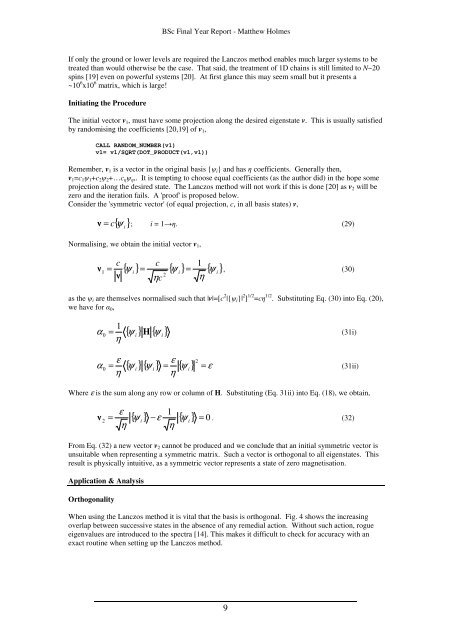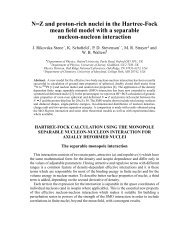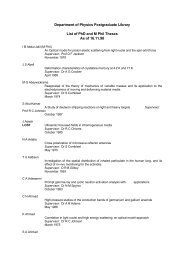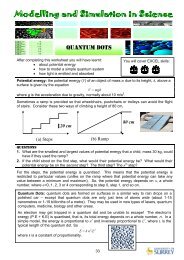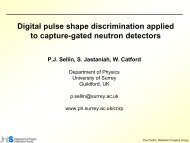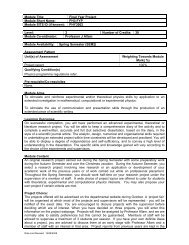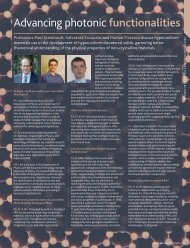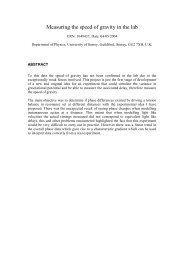The Heisenberg Antiferromagnet and the Lanczos Algorithm Abstract
The Heisenberg Antiferromagnet and the Lanczos Algorithm Abstract
The Heisenberg Antiferromagnet and the Lanczos Algorithm Abstract
You also want an ePaper? Increase the reach of your titles
YUMPU automatically turns print PDFs into web optimized ePapers that Google loves.
BSc Final Year Report - Mat<strong>the</strong>w HolmesIf only <strong>the</strong> ground or lower levels are required <strong>the</strong> <strong>Lanczos</strong> method enables much larger systems to betreated than would o<strong>the</strong>rwise be <strong>the</strong> case. That said, <strong>the</strong> treatment of 1D chains is still limited to N~20spins [19] even on powerful systems [20]. At first glance this may seem small but it presents a~10 6 x10 6 matrix, which is large!Initiating <strong>the</strong> Procedure<strong>The</strong> initial vector v 1 , must have some projection along <strong>the</strong> desired eigenstate v. This is usually satisfiedby r<strong>and</strong>omising <strong>the</strong> coefficients [20,19] of v 1 ,CALL RANDOM_NUMBER(v1)v1= v1/SQRT(DOT_PRODUCT(v1,v1))Remember, v 1 is a vector in <strong>the</strong> original basis { i } <strong>and</strong> has coefficients. Generally <strong>the</strong>n,v 1 =c 1 1 +c 2 2 +…c ,. It is tempting to choose equal coefficients (as <strong>the</strong> author did) in <strong>the</strong> hope someprojection along <strong>the</strong> desired state. <strong>The</strong> <strong>Lanczos</strong> method will not work if this is done [20] as v 2 will bezero <strong>and</strong> <strong>the</strong> iteration fails. A 'proof' is proposed below.Consider <strong>the</strong> 'symmetric vector' (of equal projection, c, in all basis states) v, = c{ ψ i}; i = 1. (29)Normalising, we obtain <strong>the</strong> initial vector v 1 ,c= { ψ } = { ψ } { ψ }1 i2 i=cηc1 , (30)ηias <strong>the</strong> i are <strong>the</strong>mselves normalised such that |v|=[c 2 |{ i }| 2 ] 1/2 =c 1/2 . Substituting Eq. (30) into Eq. (20),we have for 0 ,α1η{ } H { }ψ iψ i0 = (31i)εεα0=ii=ηη2{ ψ } { ψ } = { ψ } εi(31ii)Where ε is <strong>the</strong> sum along any row or column of H. Substituting (Eq. 31ii) into Eq. (18), we obtain,ε1{ ψ } −ε{ ψ } 02=ii= . (32)ηηFrom Eq. (32) a new vector v 2 cannot be produced <strong>and</strong> we conclude that an initial symmetric vector isunsuitable when representing a symmetric matrix. Such a vector is orthogonal to all eigenstates. Thisresult is physically intuitive, as a symmetric vector represents a state of zero magnetisation.Application & AnalysisOrthogonalityWhen using <strong>the</strong> <strong>Lanczos</strong> method it is vital that <strong>the</strong> basis is orthogonal. Fig. 4 shows <strong>the</strong> increasingoverlap between successive states in <strong>the</strong> absence of any remedial action. Without such action, rogueeigenvalues are introduced to <strong>the</strong> spectra [14]. This makes it difficult to check for accuracy with anexact routine when setting up <strong>the</strong> <strong>Lanczos</strong> method.9


